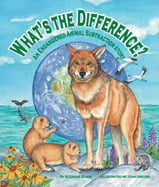Alignment to Standards for MO

| Grade | Number | Standard |
|---|---|---|
| 1 | SC-EC 1A4a. | specific organism may interact with other organisms or with the environment (e.g., pollination, shelter, seed dispersal, camouflage, migration, hibernation, defensive mechanism |
| 1 | SC-EC 1A4b. | Recognize different environments (i.e., pond forest, prairie) support the life of different types of plants and animals |
| 1 | SC-EC 1D4a. | Identify examples in Missouri where human activity has had a beneficial or harmful effect on other organisms (e.g., feeding birds, littering vs. picking up trash, hunting/conservation of species, paving/restoring green space) |
| 1 | SC-LO 1E1a. | Distinguish between plants and animals based on observable structures and behaviors |
| 1 | SC-LO 1E5a. | Explain how similarities are the basis for classification |
| 1 | SC-LO 1E5b. | Distinguish between plants (which use sunlight to make their own food) and animals (which must consume energy-rich food) |
| 2 | SC-EC 2A3b. | Classify populations of organisms as producers or consumers by the role they serve in the ecosystem |
| 2 | SC-EC 2A3c. | Sequence the flow of energy through a food chain beginning with the Sun |
| 2 | SC-EC 2A3d. | Predict the possible effects of removing an organism from a food chain |
| 2 | SC-EC 2A4a. | Classify populations of organisms as producers, consumers, or decomposers by the role they serve in the ecosystem |
| 2 | SC-EC 2A4b. | Differentiate between the three types of consumers (herbivore, carnivore, omnivore) |
| 2 | SC-EC 2A4c. | Categorize organisms as predator or prey in a given ecosystem |
| 3 | SC-EC 3C4c. | internal cues (e.g., hunger) and external cues (e.g., changes in the environment) that cause organisms to behave in certain ways (e.g., hunting, migration, hibernation |
| 3 | SC-ES 3A5b. | human activities (irrigation damming of rivers, waste management) have affected the quantity and quality of major bodies of fresh water |